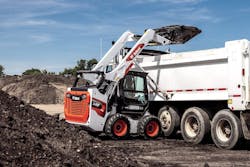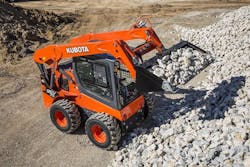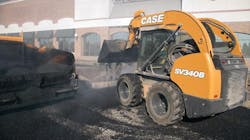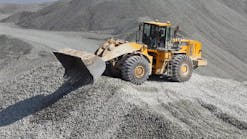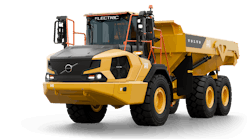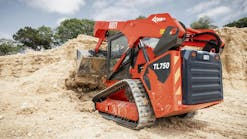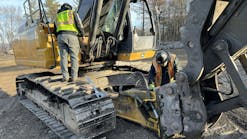Takeuchi and Volvo Construction Equipment have stopped selling skid steer loaders in North America since Construction Equipment last examined the group in 2018, and a LiuGong spokesperson said it is not promoting skid steers here at this time.
Some of the latest technology for large skid steer loaders feeds into four main trends, based on offerings from some of the most active manufacturers.
Telematics in skid steer loaders
These OEMs have incorporated tech features for telematics use, operator comfort, grade control, and “smart” attachments.
“We’ve seen industry trends lean more towards remote access to critical machine information,” says LukeGribble, solutions marketing manager for John Deere.
As many skid steer makers do, Deere offers its own telematics solution to provide operators with vital machine information.
“This type of solution helps our operators stay on top of machine monitoring, which ultimately helps the machine run better and extend the lifespan,” Gribble says. “JDLink [telematics] also helps operators quickly connect with their local dealer for machine check-ups and flag potential maintenance cycles in advance to increase overall uptime and productivity.”
How to keep operators productive
Gribble says technology surrounding operator comfort is another trending area.
“Operators want to be comfortable and confident they can work through any condition without sacrificing safety on the job. As comfortable cab conditions and improved camera technology becomes a standard in compact equipment, it will become an important factor to help with increasing productivity on the job site,” Gribble says.
Automating common, repetitive tasks also fits the comfort equation. Features once reserved for wheel loaders, excavators, graders, and dozers have worked their way down into skid steers.
“The EH Boom Performance Package on our large frame G Series skid steers automates repetitive tasks, improving job site efficiency and safety,” Gribble says. “This package offers several features to help trim cycle times, speed production, and improve job-site awareness by automating repetitive functions.”
Two skid steer makers have added ride control as their latest piece of technology with a couple of notable twists. One is automatic, the other adds a response from the loader arms.
“Auto Ride Control is our latest feature that enhances operator comfort and convenience,” says Adam Devins, product manager, skid steers, for Wacker Neuson. “When enabled, the ride control system engages when the operator is traveling and disengages when the operator moves the lift arms. Auto Ride Control reduces material spillage, provides a more cushioned ride, and eliminates the need to repetitively toggle ride control on and off.”
Blane Burroughs, Kubota CE product specialist, says the Kubota Shockless Ride (KSR) system reduces operator fatigue by softening the ride and reducing the amount of load that is lost when traveling on rough terrain. “When it’s turned on, the loader arms reduce their rigidity by going into a float-type of operation,” Burroughs says. “KSR increases comfort by absorbing more of the terrain bumps and shakes, resulting in more of the material staying in the bucket and less on the ground.”
Grade control for skid steers
Two of Deere’s large-frame skid steer loaders (330G and Deere 332G) provide help with grade control because they are available with optional onboard grade indication that provides cross-slope (roll) and main fall slope (pitch) of the machine on the in-cab monitor display.
“These are viewable as either degrees or percentages and allow real-time grade checks from the cab of the machine that reduces the need for an individual outside the cab to check grade,” Gribble says. “This is a fully integrated solution meaning that no additional hardware or software is required.”
Skid steer attachments
The latest Caterpillar skid steer models, the D3 Series, supports a line of what it calls Smart Attachments.
“This advanced machine technology allows the machine to recognize when a Smart Attachment is connected and tailor the controls and operator information to match the tool and the task,” says Kevin Coleman, a senior product specialist for Cat. “This integration allows for better machine utilization and a better finished product by delivering easy, intuitive operation of these new grading and excavating attachments.”
Coleman says three items make the smart technology and attachments work: attachment recognition, tailored controls, and special information/control screens.
“Smart technology starts with ‘Plug & Play’ attachment recognition, which means the machine understands when a smart attachment is connected,” Coleman says. “It also knows which smart attachment is connected. With the press of button, the operator can enter the Attachment Control mode.
“Once in the Attachment Control mode, the machine’s existing joystick controls are changed from the traditional drive/implement control functionality and are instead now converted to meet the control needs for the specific smart attachment that’s been attached,” Coleman says.
“This allows the machine’s joystick controls to be tailored to now provide specific control actions for the recognized smart attachment, and it eliminates the need for extra controls or complex button/trigger/switch pressing to control what traditionally are difficult-to-operate-andcontrol hydro-mechanical tools,” according to Coleman.
“This intuitive control allows the operator to focus on using and manipulating the attachment in a way that is more natural without having to focus on intricate button and control presses to operate the attachment.”
Additional control and information for the operator can be found on special display screens on the in-cab advanced display monitor, Coleman says.
“With a simple press of the button again, the operator returns to Machine Control mode, and the joysticks return to their original drive and implement control functionality.”
Caterpillar Smart Attachments for skid steers include a Smart Backhoe and Smart Grader with Assist.
For the backhoe, in-cab joystick controls are converted to allow control of boom, stick, bucket, swing, stabilizer movement, and side shift. “The operator can select their preferred control pattern, excavator or backhoe, via the in-cab display,” Coleman says.
Attachments can be added to the end of the smart backhoe, including a hammer, thumb, compactor plate, and auger, all controlled through the existing in-cab joysticks.
“Due to this integration, the need to remove the door to operate a backhoe attachment has been eliminated, allowing for safer, more comfortable operation from inside the one-piece, sealed, and pressurized cab,” Coleman says. “No more concerns about the rain, cold, or heat.”
Smart Grader with Assist is designed for grading dirt, gravel, sand, and virtually any other base material, Cat says. Once attachment recognition allows the operator to convert the in-cab joysticks to the needs of the recognized attachment, the left joystick maintains control of the machine drive functions while the right joystick is changed to operate the attachment.
“Fore and aft movement of the right-hand joystick raises and lowers the blade,” Coleman says. “When the operator moves the right joystick side to side, left, or right of center, the blade will tilt left or right respectively. The thumb roller angles the blade left or right.
“Beyond being smart, the grader blade has enhanced performance and functionality via the cross-slope assist feature,” Coleman says. “With cross slope assist enabled, the operator selects the desired cross slope of the blade by placing the blade to the desired position
“The in-cab advanced display monitor provides the operator information regarding the cross slope of the blade as well as the blade rotation angle,” Coleman explains. “Then the attachment automatically works to maintains that desired slope. The Smart Grader can also be combined with 2D or 3D external reference systems for even higher levels of grading accuracy.”
New monitors for skid steer
Another tech achievement is Case Construction Equipment’s 8-inch monitor on its B Series skid steers.
“Visibility is such an important consideration when operating around busy job sites,” says George MacIntyre, Case product manager for skid steers and CTLs. “For this reason, we’ve incorporated a split-screen 8-inch LCD multifunction color display with a back-up camera as standard equipment on all B Series skid steer units with EH controls. The camera, which operates in both forward and reverse, can be viewed in split-screen alongside other operational data and machine settings, which is an industry first.”
